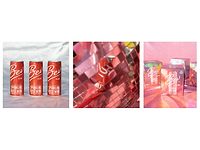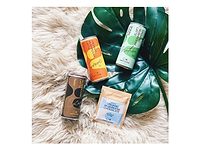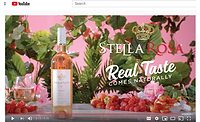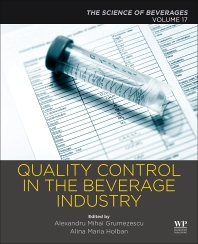![]()
Doing what comes naturally
Fetzer leads organic change in the wine industry
By SARAH THEODORE
When Fetzer Vineyards
began growing organic grapes during the 1980s, it had no intention of
leading a consumer trend toward organic products — in fact, most wine
consumers would be surprised to know the company is the largest grower of
organic grapes in the country. But given today's growth in natural
and organic products, it seems Fetzer might have known it was on to
something from the start.
Fetzer's organic practices
grew from a belief that organic grapes produced more flavorful, higher
quality wine. The move prompted a series of other changes within the
company toward sustainable business practices, but they have, for the most
part, been quiet changes. Until now, that is.
The company, based in Hopland, Calif., is starting to
be more vocal about its message of organics and sustainability. Last year,
it announced a goal of using 100 percent organic grapes by 2010, which
means it has asked the 250 other growers from which it buys grapes to make
at least part of their operations organic.
Fetzer President Paul Dolan also recently penned a
book titled "True to our Roots: Fermenting a Business
Revolution", in which he shares the company's environmental
philosophy and the key principles of creating a sustainable business.
"For the longest time, I thought it was more important for us
to walk the walk than talk the talk. When you get caught up in talking about
it, it distracts you from actually doing the work," he says. "I knew there would
be a time to say something, and that came with the book. We have a commitment
to sharing this, not just providing leadership, but also giving [our knowledge]
away so that others can take it on."
To most of the world, Fetzer will look as it always
has — for one thing, the wines still will not be organic wines, even
after 2010 (Organic wines cannot contain added sulfites, which Fetzer
considers essential to quality winemaking). As it has been from the start,
the company is focused on sustainability as a business practice rather than
as a consumer message.
Regardless, the company picked a good time to do it.
Retail chains such as Whole Foods, Wild Oats and Trader Joe's have
grown by leaps and bounds, and organic foods and beverages are more
mainstream than ever before, growing 20 percent per year, according to the
Organic Trade Association. The trend also is becoming more prevalent in the
wine business, with 2 percent of California wineries now certified organic,
according to the California Certified Organic Farmers. While that might not
seem like a lot, it's twice as much as a decade ago.
The power of three
Fetzer has been making wines since 1968, and is one of
the leading producers of varietal wines in the world. Dolan says the decision to farm organically began with a
"lightbulb" moment when he tasted a grape grown organically and
then one grown with more conventional methods. He immediately noticed more
flavor and positive attributes in the organically grown grape.
"We converted that vineyard to organic, and three years later
that wound up going into our best wine," he says.
Organic farming prohibits the use of chemical
fertilizers, pesticides and fungicides.
Instead, the company relies on natural methods, including cover crops and
other non-grape plants to attract beneficial insects that feed on the
destructive insects.
The conversion to organic farming led the company to
consider more sustainable practices in other aspects of its business as
well. Over time, Fetzer has come to believe that "being good"
can be good for business.
"I started to see that there was another way to run the business,
and we started to look at everything," Dolan says. "We organized around a 'triple
bottom line' as opposed to a single financial bottom line as most businesses
are organized around."
Pat Voss, senior vice president and general manager at
Fetzer Vineyards, explains that the theory of a triple bottom line calls
for several factors to enter into decision-making.
"It's about being profitable — no margin, no mission," she says.
"It's about being environmental, and it's about treating people in a just and
equitable way. We know that sometimes we're going to fail at one or more of
those, but at least we're asking ourselves the questions — we're not just making
decisions based on one of those."
Asking the questions has inspired creativity that is evident
everywhere at the company's Valley Oaks headquarters in Mendocino County. Its
office building was created with 18-inch thick earthen walls, the ceilings made
from wood recycled from old California barns, the 100-year-old doors were recycled
from an old utility company and the offices run on green power.
"Each step of the way, we've found so many things. We can't
take them all on, but we take on as many as we financially and physically can,"
says Dolan.
In 1992, Fetzer became part of Brown-Forman Corp., which also sells brands such as Sonoma Cutrer
and Korbel along with several imports. The association is a boon to the
company's marketing efforts as it can draw on the full sales and
educational programs allowed by the Brown-Forman portfolio. And
Brown-Forman has pulled some of Fetzer's philosophies into the larger
company as well.
"In the beginning, when people from Fetzer were talking about
the environmental position, and Paul was very passionate about it, you saw a
lot of skepticism. It was like 'this is a California thing'," Voss says. "This
year, Brown-Forman convened the first Brown-Forman conference on sustainability.
They had 200 of the top executives and managers in the company in the room and
said 'We are in a sustainable business. We are going to manage and run this
company using sustainable business practices.'
All eyes on 2010
The decision to use only organic grapes in its
products was an idea proposed by company employees, according to Doug
Wilson, Fetzer's head of grower relations.
"Every two years we get together and start identifying big goals,"
he says. "The original goal was to do it in 2020, but we decided that wasn't
much of a commitment. I proposed that we do it by 2010."
Not sure if he had walked into a grower-relations
minefield with that proposal, Wilson says,
"We thought it would be interesting to see who bailed immediately. I
waited for the phone to ring, and it never rang," he says.
Part of Fetzer's education mission is to help
other wineries understand the possibilities of organic farming, both for
its own grower partners and others in the industry. The company has begun a
series of educational seminars at Valley Oaks, and it brought onboard Ann
Thrupp, a former U.S. Environmental Protection Agency life scientist and
director of sustainable agriculture at the World Resources Institute in
Washington, D.C., as manager of organic development.
"We're having a profound effect over the wine industry, not
just in California, but across the country," says Hoke Harden, manager of global
wine education at Brown-Forman. "There are people who are, for the first time,
understanding that this is not a screwball concept. This is attainable, it's
doable. It's farming responsibly, but still with an eye toward the financial
implications."
It takes three years of organic farming to gain
certification, so Fetzer began by asking its growers to spend a little time
finding out if they were willing to go that direction.
"We said, 'We want you to think about it.
We want you to take five acres of your best vineyard, not your worst
vineyard, your best, because you're going to be most successful in
the best part of your vineyard. We want you to think about weed control and
pesticide control and fungicides'," Wilson says.
"It's nerve-wracking to watch flies in your vineyard and wait
for these beneficial insects to build up enough of a population to attack them,
but it's the most powerful thing," he says. "It's much better than any sort
of pesticide. Pesticides are non-selective, so they kill good bugs and bad bugs.
But with beneficials, they attack the food source and then move on."
A more global business
Organic farming is a new way of looking at the
business for many wineries, but it's not the only variable the U.S.
wine industry has had to examine during the past several years.
Competition is increasing, with a growing number of domestic
and import brands entering the market. And while popular bargain-priced wines
have appealed to new wine consumers, they also have put even more pressure on
already competitive pricing.
Dolan, who serves on the board of the Wine Institute, says the
challenges have forced the industry to consider things it's never had to think
about before. "We've talked global for a long time, but the wine business is
just now experiencing what global means," he says. "We're going through a bit
of a retooling period, and we haven't had to do that in this industry. It has
just kind of grown simply."
Expanding wine consumption is one of the most important industry
goals, he says.
"The biggest potential opportunity we have right now is to make
wine available to more consumers," he says. "Ten percent of the population drinks
86 percent of the wine. If that's the case, maybe we could increase consumption
by reaching out to those consumers who are now drinking beer or ready-to-drinks
and introduce them to wine."
To target specific
consumers, Fetzer has developed a consumer profile that goes beyond the
general wine consumer, which is thought to be 35 to 50 years old, fairly
affluent, and socially and physically active.
"The problem at that level of granularity is
that there's not much you can do to
differentiate your promotions from anybody else's," says Doug
Gillespie, U.S. brand director at Fetzer. As a result, the company has
added lifestyle pursuits such as cooking and
gardening to its consumer profile.
"We can tailor our promotions and our
promotional partners and even our packaging toward those types of cues.
It's a more sophisticated way of looking at the target," says
Gillespie.
Kicking it up a notch
The food/wine connection is an especially strong tool
for Fetzer. The company's own chef, John Ash, has written books and
appeared on numerous television programs, Fetzer has hosted a bevy of
prestigious chefs at Valley Oaks, it holds an annual red wine and chocolate
festival, and it has a partner in chef and restaurant owner Emeril Lagasse.
"I think the best part about wine is its relation to food, the
way it complements food and fits naturally on the table," says Dolan. "Emeril
is great because he makes food fun, and the other chefs, the Charlie Trotters
of the world, go to depths to make food special and unique." The company's partnership
with Lagasse includes two lines of wine, Emeril's Classics, which are sold at
retail, and Emeril's Reserve, which are exclusive to Lagasse's nine restaurants.
Fetzer also hosts the Emeril Under the Stars and Emeril in the Harvest Sun festivals
at Valley Oaks to raise money for the Emeril Lagasse Foundation, which funds
educational programs for at-risk kids.
"The great thing is that while we have a contract with Emeril,
most of the stuff you see is well outside the contract because it's a win-win
for both of us," says Gillespie. "We're raising money for his foundation and
we're doing great things for the winery. It's a tremendous event for us."
In addition to consumer marketing, Fetzer has special
educational programs for professionals in the trade. The company's
ties to Brown-Forman are especially helpful in this effort. The
Brown-Forman Center for Wine Education is based at Valley Oaks and hosts
in-depth seminars for its distributors, wholesalers, restaurants and
hospitality partners.
The three-day program takes attendees into the vineyards, through tastings and aroma training,
helps them understand food pairings, and helps them make wine more
understandable and accessible to consumers. That's an endeavor that
Dolan thinks is important.
"What we haven't been willing to do as an
industry is notice that we are an elitest beverage. We tend to talk down to
consumers and make it difficult to understand wine," he says.
In addition to Fetzer wines, the program includes Brown-Forman's
other wines and brands from other companies. "We go out there and taste competitors'
wines along with our products because that gives the total global viewpoint
of wine," says Harden, who leads the trade education effort. "We want you to
know about our wines, but we also want you to know the basics of wine in general
so you can be informative to [consumers]." In the field, the company also works
with its customers to develop wine lists and even develop menus.
A sense of place
With the onslaught of competitive brands in the wine market,
Fetzer has decided that its heritage and the uniqueness of its home at Valley
Oaks could be a message that appeals to consumers. It is getting set to roll
out new labels for its Fetzer branded products that communicate those things,
and it hopes the new packaging will help set it apart from the sea of brands
that are not connected to a specific place.
To emphasize the Valley Oaks connection, the company also will
fold its current brand designations such as Sundial, Eagle Peak and Echo Ridge
under a single Fetzer Valley Oaks name, while maintaining the current Barrel
Select and Reserve tiers. The new look will hit the market later this year.
"With the competition increasing and getting more severe, it's
increasingly important for us to stand out in the wine category and among our
tighter competitive set, and more difficult too, because there are more wine
brands," says Gillespie. "For us, this is not simply an evolutionary package.
It's speaking more to who we are."
"There are so many wines out there that are just
labels," he says. "Fetzer comes from a special place and
because of that, it's a special wine." BI




